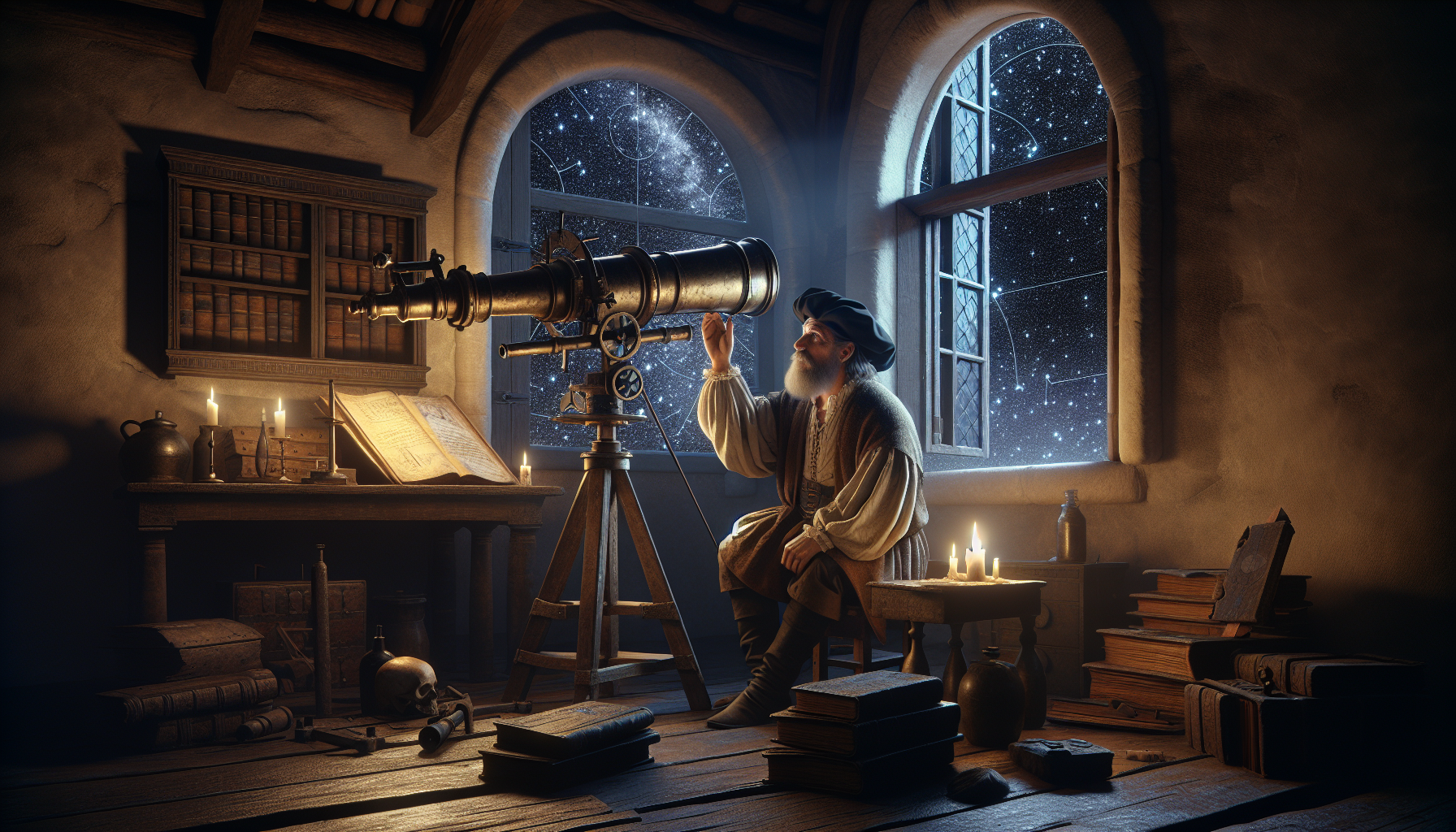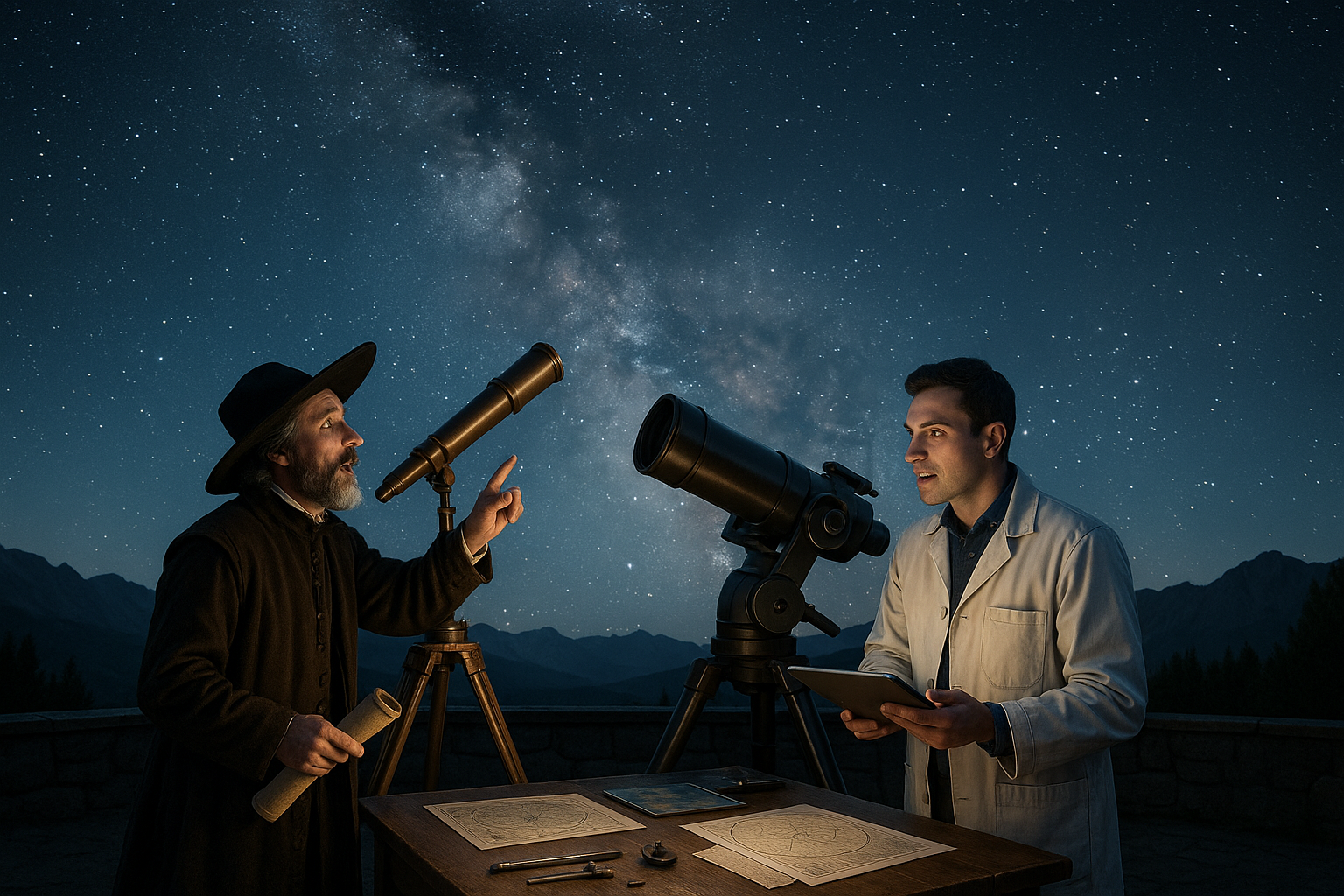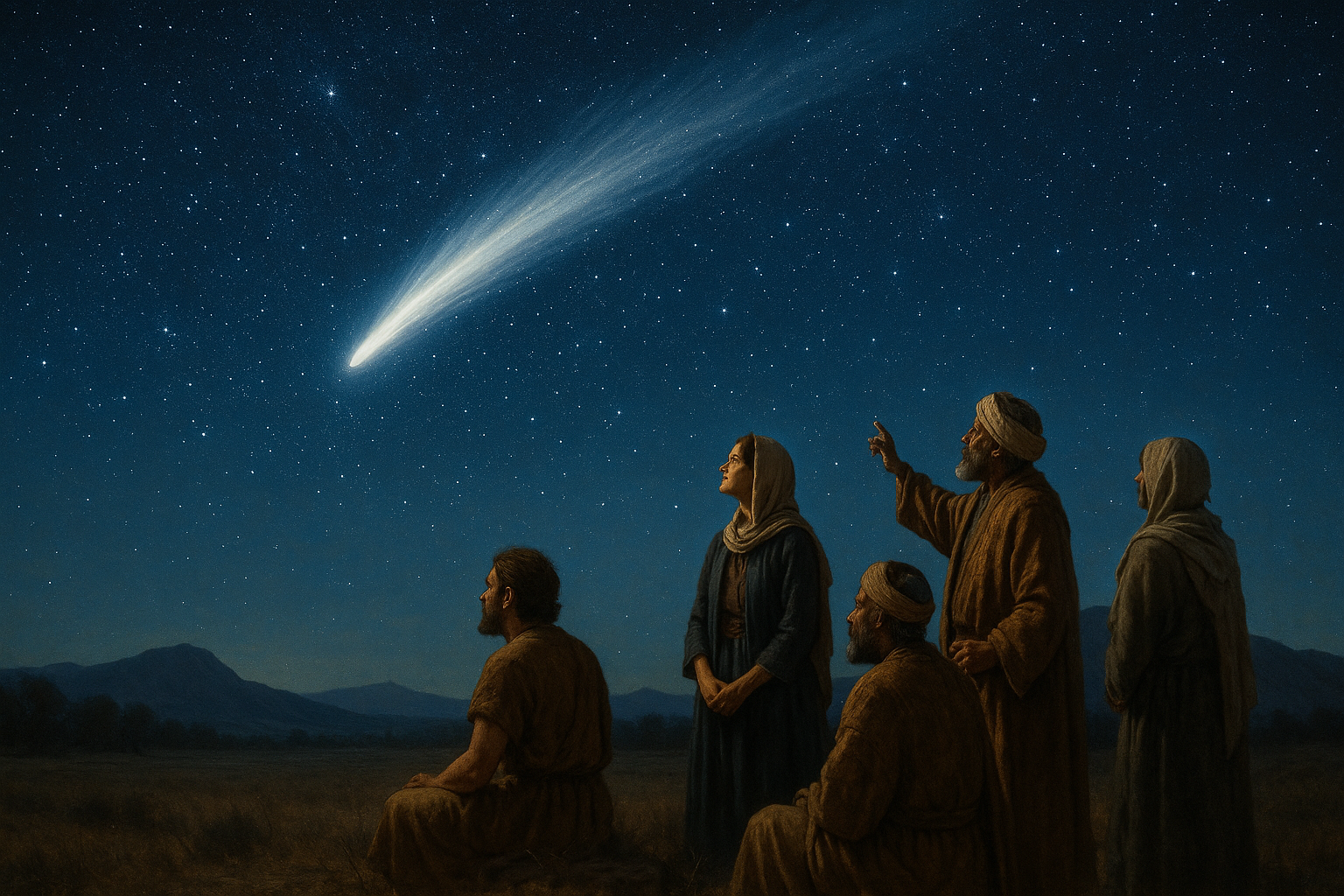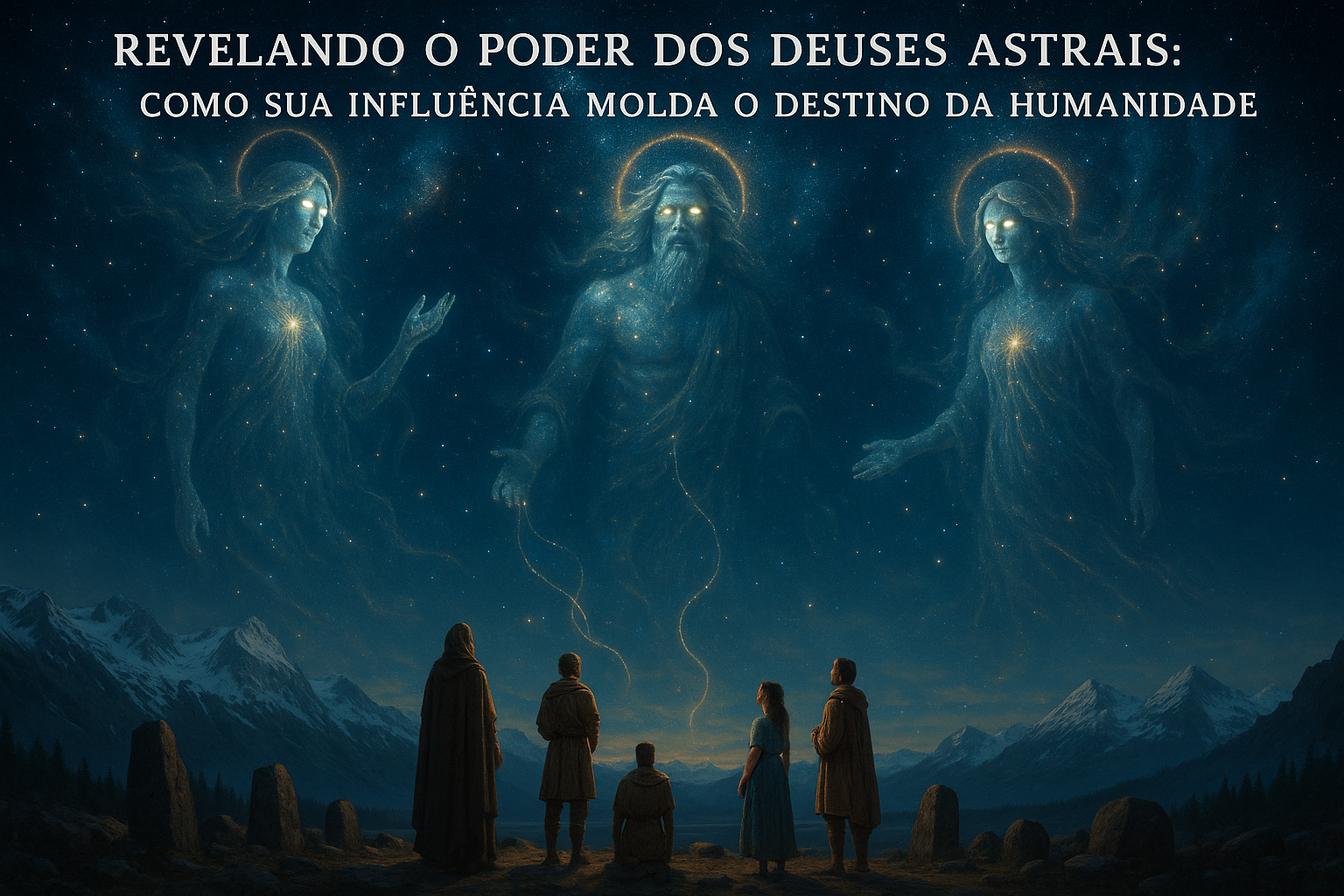The night sky has always been a canvas of mystery and wonder, a vast expanse that has captivated the human imagination for millennia. Long before modern technology illuminated the secrets of the cosmos, early astronomers gazed up at the stars with a mixture of awe and curiosity. But it wasn’t until the invention of the telescopic lens that the heavens truly began to reveal their secrets. This transformative tool not only changed the course of astronomy but also reshaped our understanding of the universe and our place within it. Join us as we embark on a journey through time, exploring the pioneering days of telescopic lens use in early astronomy, a story of innovation, exploration, and the unyielding quest for knowledge.
Imagine a world where the night sky was a tapestry of stories, woven from the threads of mythology and tradition. For centuries, civilizations around the globe looked to the stars for guidance, interpreting their patterns as omens, calendars, and maps. However, without the aid of telescopic lenses, these early stargazers were limited to what they could observe with the naked eye. The celestial bodies were mere points of light, distant and enigmatic. The advent of the telescopic lens in the early 17th century marked a pivotal moment in history, a turning point that would forever alter the landscape of astronomy and propel humanity into a new era of discovery. 🔭
The introduction of the telescopic lens was a technological leap that expanded the boundaries of human perception. Suddenly, the moon was no longer just a glowing orb in the night sky, but a complex world with mountains, valleys, and craters. The planets, once indistinguishable from stars, revealed their unique characteristics and began to tell their own stories. This new tool allowed astronomers to peer deeper into the cosmos, unveiling the intricacies of the universe with unprecedented clarity. The pioneering use of telescopic lenses by visionaries such as Galileo Galilei and Johannes Kepler not only revolutionized the field of astronomy but also challenged prevailing beliefs and ignited a scientific revolution that would ripple through the centuries.
As we delve into the early days of telescopic lens use in astronomy, we’ll explore the remarkable discoveries that unfolded during this transformative period. From Galileo’s first observations of Jupiter’s moons to Kepler’s groundbreaking work on planetary motion, these milestones represent the dawn of a new scientific era. We’ll examine the challenges and controversies faced by these early astronomers, whose groundbreaking work often put them at odds with the established doctrines of their time. Through their stories, we’ll gain insight into the relentless pursuit of truth and the courage required to challenge conventional wisdom.
In this exploration of the pioneering days of telescopic lens use in early astronomy, we will uncover not only the scientific advancements that reshaped our understanding of the cosmos but also the human stories behind these discoveries. The passion, perseverance, and ingenuity of these early astronomers continue to inspire generations, reminding us of the boundless possibilities that await those who dare to look beyond the horizon. So, sit back and let us guide you through this fascinating journey, as we unveil the stars and pay homage to the trailblazers who first dared to glimpse into the unknown. 🌟
The Dawn of Telescopic Astronomy
The invention of the telescope marked a profound turning point in the history of astronomy, forever changing our perception of the universe. The device, credited to Hans Lippershey in 1608, was initially intended for terrestrial observations, but its potential for celestial viewing was quickly realized. This period in history, often referred to as the dawn of telescopic astronomy, is characterized by rapid advancements in both technology and knowledge.
Before the telescope, astronomers relied heavily on the naked eye and rudimentary tools, like astrolabes and quadrants, to study the heavens. This method, while useful, was limited in its capacity to discern the intricate details of celestial bodies. The telescope shattered these limitations, offering a magnified view of the sky and enabling the observation of phenomena previously invisible to the human eye. This newfound capability led to significant discoveries, such as the identification of Jupiter’s moons and Saturn’s rings.
The adoption of the telescope in astronomy quickly accelerated the field’s development. Pioneering astronomers such as Galileo Galilei and Johannes Kepler were at the forefront of this revolution. Galileo, for instance, improved upon the basic design of the telescope and was among the first to use it for systematic astronomical observations. His findings, including the phases of Venus and the rugged surface of the Moon, challenged long-held beliefs about the cosmos and supported the heliocentric model proposed by Copernicus.
Galileo’s Contributions to Telescopic Astronomy
Galileo Galilei’s contributions to telescopic astronomy were groundbreaking and remain pivotal in the history of science. His improvements to the telescope’s design allowed for greater magnification and clearer images, making it a crucial tool for astronomical research. Galileo’s observations of Jupiter’s four largest moons provided compelling evidence that not all celestial bodies orbited the Earth, as was commonly believed at the time. This discovery was instrumental in the gradual acceptance of the heliocentric theory.
Additionally, Galileo’s documentation of the Moon’s surface revealed a world of craters and mountains, dispelling the notion that celestial bodies were perfect and immutable. His work laid the foundation for future astronomical research and inspired generations of scientists to explore the cosmos with telescopes. To gain a better understanding of Galileo’s work, consider watching this informative video: The Legacy of Galileo Galilei – PBS Space Time.
The Evolution of Telescopic Technology
The early days of telescopic astronomy were marked by rapid advancements in technology. The initial designs, though revolutionary, were rudimentary by today’s standards. As astronomers recognized the telescope’s potential, efforts to enhance its performance led to the development of more sophisticated instruments. The transition from simple refracting telescopes to more complex reflecting telescopes was a significant milestone in this evolution.
Refracting telescopes, which use lenses to focus light, were the first to be developed. However, they suffered from issues such as chromatic aberration, where different colors of light focused at different points, leading to distorted images. To combat this, astronomers like Johannes Kepler and Isaac Newton experimented with alternative designs. Newton’s invention of the reflecting telescope, which uses mirrors instead of lenses, was a breakthrough that addressed many of these optical problems.
The following table highlights the key differences between refracting and reflecting telescopes:
| Feature | Refracting Telescope | Reflecting Telescope |
|---|---|---|
| Optical Element | Lens | Mirror |
| Primary Issue | Chromatic Aberration | Obstruction by Secondary Mirror |
| Cost | Generally Higher | Generally Lower |
| Durability | More Delicate | More Robust |
As you can see from the table, each type of telescope has its advantages and limitations. Reflecting telescopes, with their reduced chromatic aberration and generally lower cost, became more popular for advanced astronomical research. The evolution of these instruments laid the groundwork for modern telescopes, which now incorporate advanced materials and computerized systems for enhanced precision and data collection.
The Impact of Telescopic Discoveries
The introduction of telescopic technology not only revolutionized the field of astronomy but also had profound effects on society as a whole. The ability to observe distant celestial bodies brought about a new understanding of the universe and our place within it. It challenged long-held beliefs, prompting a reevaluation of scientific and philosophical ideas.
One of the most significant impacts of telescopic discoveries was the shift from the geocentric to the heliocentric model of the solar system. This paradigm shift was not just a scientific breakthrough but also a cultural one, as it fundamentally altered humanity’s view of itself in relation to the cosmos. The works of astronomers like Copernicus, Galileo, and Kepler, supported by telescopic evidence, played a crucial role in this transformation.
Moreover, the revelations brought about by telescopic astronomy spurred the advancement of other scientific fields. The need to understand and interpret the new data led to developments in mathematics, physics, and optics. Additionally, the increased interest in the stars and planets influenced art, literature, and philosophy, inspiring a sense of wonder and curiosity about the universe.
The Role of Amateur Astronomers
Amateur astronomers have played a significant role in the development of telescopic astronomy. Despite the challenges of limited resources and access to advanced technology, many amateur astronomers have made notable contributions to the field. Their passion and dedication have led to the discovery of comets, asteroids, and variable stars, among other phenomena.
The involvement of amateurs in astronomy has been facilitated by the increasing accessibility of telescopic equipment. As technology advanced, telescopes became more affordable and easier to use, allowing more people to participate in astronomical observations. This democratization of astronomy has led to a rich community of enthusiasts who continue to explore the skies and contribute valuable data to the scientific community.
For those interested in joining the ranks of amateur astronomers, the following resources can be invaluable:
- Sky & Telescope – A resource for news, observing tips, and equipment reviews.
- Astronomical League – An organization that provides programs and resources for amateur astronomers.
- “A Beginner’s Guide to Astronomy” – Night Sky Network
Amateur astronomers continue to play a vital role in the field, often collaborating with professional astronomers to monitor celestial events and phenomena. Their contributions demonstrate the power of curiosity and the enduring human desire to explore the unknown.

Conclusion
Unveiling the Stars: The Pioneering Days of Telescopic Lens Use in Early Astronomy
In conclusion, the exploration of the pioneering days of telescopic lens use in early astronomy reveals a remarkable journey that shaped our understanding of the universe. The advent of the telescope marked a pivotal moment in scientific history, offering humanity a window to the stars and transforming our perception of the cosmos. Throughout this article, we have traversed the historical landscape of astronomical discovery, from the rudimentary lenses crafted by visionaries like Hans Lippershey and Galileo Galilei to the profound impact these inventions had on the scientific community and society at large.
The introduction of the telescope in the early 17th century heralded a new era of observational astronomy. Galileo’s enhancements to the telescope allowed him to make groundbreaking observations, such as the discovery of the four largest moons of Jupiter and the detailed study of lunar craters. These findings not only challenged the geocentric model of the universe but also laid the groundwork for the Copernican revolution. The telescope became an emblem of scientific progress, igniting curiosity and fostering a spirit of inquiry that continues to drive astronomical research to this day.
Moreover, the use of telescopic lenses catalyzed a cultural shift, bridging the gap between science and society. The ability to observe celestial bodies with unprecedented clarity inspired awe and wonder, prompting philosophical debates and challenging established beliefs. This era of discovery underscored the importance of empirical observation and critical thinking, principles that remain fundamental to the scientific method. As we reflect on the contributions of early astronomers, it becomes evident that their work was not just about mapping the stars but about expanding the horizons of human knowledge.
The legacy of these pioneering days extends beyond the scientific community. The innovations born out of this era laid the foundation for technological advancements that have permeated various aspects of modern life. The principles of optics and lens design, initially developed for telescopes, have found applications in fields ranging from photography to medicine. This cross-pollination of ideas exemplifies the interconnectedness of scientific disciplines and highlights the far-reaching impact of early astronomical pursuits.
In recognizing the significance of these early achievements, we are reminded of the importance of curiosity and perseverance in the face of the unknown. The astronomers of the past faced considerable challenges, yet their unwavering dedication and innovative spirit propelled them to transcend the limitations of their time. Their stories serve as a testament to the power of human ingenuity and the enduring quest to unravel the mysteries of the universe.
As we conclude our exploration of the pioneering days of telescopic lens use in early astronomy, let us celebrate the profound legacy of these trailblazers. Their contributions have paved the way for contemporary astronomers, whose work continues to push the boundaries of what is possible. In an age where technology allows us to peer deeper into the cosmos than ever before, we must not forget the humble beginnings that set us on this path of discovery.
We encourage you, dear reader, to carry forward the spirit of curiosity and exploration. Whether you are an aspiring astronomer, a science enthusiast, or someone captivated by the wonders of the universe, let this journey inspire you to seek knowledge and share it with others. Engage with the vibrant community of stargazers and researchers, and consider how you might contribute to the ongoing dialogue about our place in the cosmos.
If this article has sparked your interest, we invite you to delve deeper into the fascinating world of astronomy. Visit observatories, attend stargazing events, or explore online resources that offer insights into the latest discoveries. Share your newfound knowledge with friends and family, and encourage them to look up at the night sky with renewed wonder. By fostering a collective appreciation for the cosmos, we can ensure that the legacy of early astronomical pioneers continues to inspire future generations.
🔭✨ In this age of information, the stars are closer than ever, waiting to unveil their secrets to those who dare to look. Let’s embrace this journey together and keep our eyes on the skies. 🌌
For further exploration, consider visiting reputable sources such as NASA and The European Space Agency. These platforms offer a wealth of information and up-to-date research on astronomical phenomena and technological advancements.
In closing, let us acknowledge the profound impact of early telescopic discoveries on our understanding of the universe. The pioneering efforts of astronomers like Galileo Galilei set in motion a chain of events that transformed our worldview and continues to shape the scientific landscape. May we carry forward their legacy with curiosity, courage, and a commitment to exploring the infinite wonders of the cosmos.
Toni Santos is a visual storyteller and cosmic interpreter whose work illuminates the ancient skywatchers and their prehistoric astronomy—the profound ways early humans observed and revered the heavens before written history. Through a visionary lens, Toni explores how the stars, planets, and celestial cycles shaped myth, ritual, and survival in cultures lost to time.
Rooted in a fascination with archaic observatories, stone alignments, and celestial symbolism, Toni’s creative journey reveals the deep human impulse to understand and harmonize with the cosmos. From lunar phases guiding planting seasons to the sacred paths of the Milky Way, each of his works embodies the awe and knowledge encoded in the night sky.
Combining artistic craftsmanship with archaeological insight, Toni’s pieces evoke the mystery and precision of prehistoric astronomers. His work does more than depict—it channels the timeless dance between earth and sky, bridging ancient wisdom with contemporary wonder.
As the visionary behind Vizovex, Toni shares curated visuals, essays, and symbolic studies that invite others to reconnect with the cosmic heritage written in stone and starlight. His creations are a call to look upward, to listen to the silent stories told by the stars, and to honor the first astronomers who mapped the heavens with reverence and ingenuity.
His work is a tribute to:
The celestial wisdom of prehistoric peoples
The sacred geometry of ancient observatories
The enduring bond between human culture and the cosmos
Whether you’re a stargazer, a scholar of ancient mysteries, or someone captivated by the universe’s earliest storytellers, Toni welcomes you to journey through a space where the sky is both map and myth—one constellation, one ritual, one revelation at a time.




